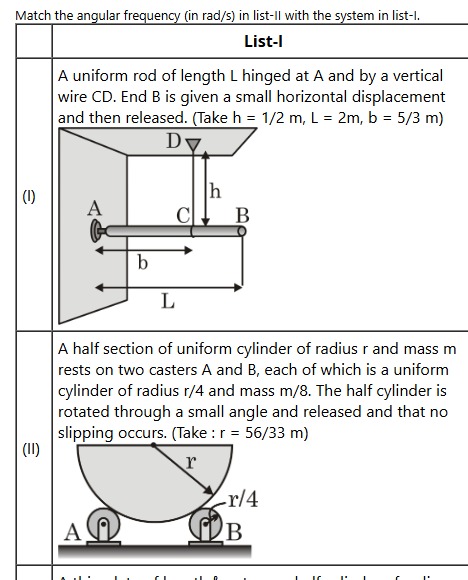Question
Question: Match the angular frequency (in rad/s) in list-ll with the system in list-l. **List-l** A uniform ...
Match the angular frequency (in rad/s) in list-ll with the system in list-l.
List-l
A uniform rod of length L hinged at A and by a vertical wire CD. End B is given a small horizontal displacement and then released. (Take h = 1/2 m, L = 2m, b = 5/3 m)
(1)
A half section of uniform cylinder of radius r and mass m rests on two casters A and B, each of which is a uniform cylinder of radius r/4 and mass m/8. The half cylinder is rotated through a small angle and released and that no slipping occurs. (Take: r = 56/33 m)
(II)

Without List-II, a definitive answer cannot be provided. However, based on calculations, the angular frequency for system (I) is likely 5 rad/s.
Solution
The problem involves calculating the angular frequency of small oscillations for two different systems.
System (I): Uniform rod hinged at A and supported by a vertical wire CD.
Assuming the oscillation is in the vertical plane about the hinge A, and the equilibrium position is horizontal, the angular frequency is derived as:
ω=2hL3gb
Given h=1/2 m, L=2 m, b=5/3 m, and taking g≈10 m/s2:
ω=2×(1/2)×23×10×(5/3)=250=25=5 rad/s.
System (II): Half section of uniform cylinder on two casters.
The half cylinder has mass m and radius r. The casters are uniform cylinders of radius r/4 and mass m/8. No slipping occurs. The derivation for the angular frequency is complex and involves considering the kinetic and potential energies of the system. The formula derived is:
ω2=r(135π2−128)96gπ
Given r=56/33 m and g=9.8:
ω2≈3356(135π2−128)96×9.8×π≈4.29
ω≈4.29≈2.07 rad/s.
Without List-II, a definitive matching of angular frequencies to systems is not possible. However, based on calculations, system (I) is most likely associated with 5 rad/s.
